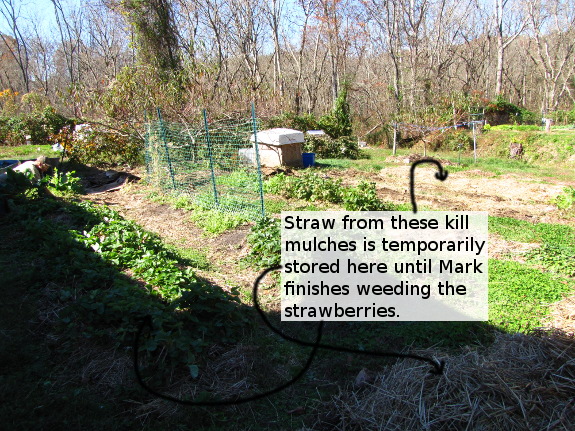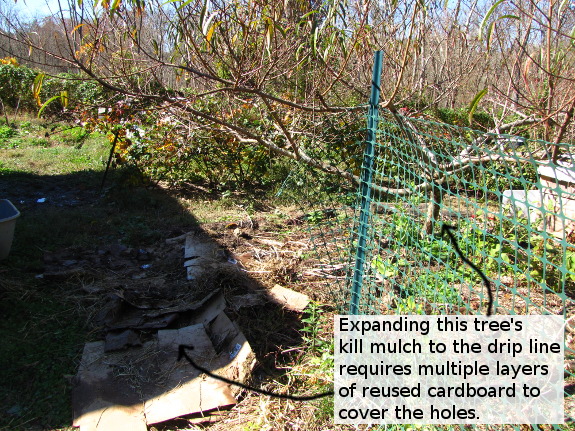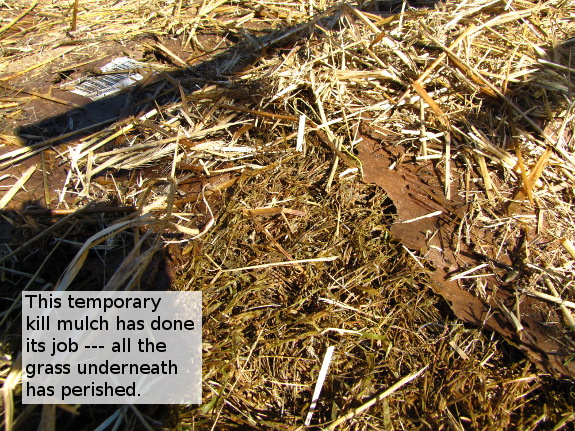
How to plant into a kill mulch

I get a lot of questions
from folks asking when to take apart a kill
mulch and how to plant into it. In general, I like to lay down
kill mulches that will rot in place and never be messed with again, but
now and then I make more temporary
kill mulches.

As an example of a
temporary kill mulch, I laid down sheets of cardboard covered by straw
to kill the last of the ryegrass about six weeks ago, and now
I want to plant rye
there to keep growing biomass over the winter. So I simply
scooped up the straw and moved it to another part of the vegetable
garden, then peeled back the partially rotted cardboard, which I piled
up to make a more permanent kill mulch expanding a peach bed. The
grass underneath was all dead but only partially decomposed, so I raked
it to the edge of the bed to keep rotting before scattering rye seeds
on top of the damp soil.

If you don't have a
reason to direct-seed into a young kill mulch,
though, you'll get more biomass into the soil by leaving the cardboard
in place. During a damp, warm summer, cardboard completely
disappears in a few months, and a cold, wet winter will do the same
job, if more slowly. (Counterintuitively, newspaper rots less
quickly, but even it will dissipate in a few summer months.) Then
you can simply rake the straw to the edge of the bed for later if
you're going to be scattering seeds, or open up a small hole for
transplanting tomatoes or garlic bulbs. Instant no-till garden!
Want more in-depth information? Browse through our books.
Or explore more posts by date or by subject.
About us: Anna Hess and Mark Hamilton spent over a decade living self-sufficiently in the mountains of Virginia before moving north to start over from scratch in the foothills of Ohio. They've experimented with permaculture, no-till gardening, trailersteading, home-based microbusinesses and much more, writing about their adventures in both blogs and books.
Want to be notified when new comments are posted on this page? Click on the RSS button after you add a comment to subscribe to the comment feed, or simply check the box beside "email replies to me" while writing your comment.

It will be interesting to see how well, or not, my new kill mulches rot over the winter in this extremely dry climate. hopefully we will get good snows this year to keep things wetter. Things have been down about a month now, with no signs of breaking down yet. :-(. In fact, the kill layer, even though covered by at least 6 inches of mulch and manure, is mostly still dry. As a further experiment, I left one section of the new garden without a kill mulch layer... Just adding all the biomass and manure I can get. And one small area is receiving the benefit of daily chicken visits also.
I was the beneficiary of roles of old carpet. I mow the old hay fields and lay a thick layer on the proposed bed. Rolling the carpet out on top allows the rain to soak slowly through and keep the light out to that any seeds in the grass don't sprout and take over. This fall I rolled up the carpet and raked the remaining mulch to the sides and seeded winter wheat for the chickens. then I put a lighter grass mulch over the seeding to discourage weeds and birds. This past summer it was entertaining to watch the large rooster bend the tall wheat stems down so that the shorter hens could beck the grain off. Hans @ Qberry Farm [pictures on Facebook]